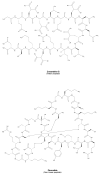Neuroprotective and cardioprotective conopeptides: an emerging class of drug leads
- PMID: 19333868
- PMCID: PMC2878759
Neuroprotective and cardioprotective conopeptides: an emerging class of drug leads
Abstract
The peptides in the venoms of predatory marine snails belonging to the genus Conus ('cone snails') have well-established therapeutic applications for the treatment of pain and epilepsy. This review discusses the neuroprotective and cardioprotective potential of four families of Conus peptides (conopeptides), including omega-conotoxins that target voltage-gated Ca2+ channels, conantokins that target NMDA receptors, mu-conotoxins that target voltage-gated Na+ channels, and kappa- and kappaM-conotoxins that target K+ channels. The diversity of Conus peptides that have already been shown to exhibit neuroprotective/cardioprotective activity suggests that marine snail venoms are a potentially rich source of drug leads with diverse mechanisms.
Figures


Similar articles
-
Conus peptides and neuroprotection.Curr Opin Investig Drugs. 2002 Jun;3(6):915-20. Curr Opin Investig Drugs. 2002. PMID: 12137413 Review.
-
Conus venom peptide pharmacology.Pharmacol Rev. 2012 Apr;64(2):259-98. doi: 10.1124/pr.111.005322. Epub 2012 Mar 8. Pharmacol Rev. 2012. PMID: 22407615 Review.
-
Novel analgesic ω-conotoxins from the vermivorous cone snail Conus moncuri provide new insights into the evolution of conopeptides.Sci Rep. 2018 Sep 7;8(1):13397. doi: 10.1038/s41598-018-31245-4. Sci Rep. 2018. PMID: 30194442 Free PMC article.
-
Pruning nature: Biodiversity-derived discovery of novel sodium channel blocking conotoxins from Conus bullatus.Toxicon. 2009 Jan;53(1):90-8. doi: 10.1016/j.toxicon.2008.10.017. Epub 2008 Nov 20. Toxicon. 2009. PMID: 18950653 Free PMC article.
-
Pharmacological Classes of Conus Peptides Targeted to Calcium, Sodium, and Potassium Channels.Protein Pept Lett. 2023;30(11):913-929. doi: 10.2174/0109298665279447231106072246. Protein Pept Lett. 2023. PMID: 38008946 Review.
Cited by
-
The Terebridae and teretoxins: Combining phylogeny and anatomy for concerted discovery of bioactive compounds.BMC Chem Biol. 2010 Sep 17;10:7. doi: 10.1186/1472-6769-10-7. BMC Chem Biol. 2010. PMID: 20849634 Free PMC article.
-
Distinct RNA degradation pathways and 3' extensions of yeast non-coding RNA species.Transcription. 2011 May;2(3):145-154. doi: 10.4161/trns.2.3.16298. Transcription. 2011. PMID: 21826286 Free PMC article.
-
A Conus regularis conotoxin with a novel eight-cysteine framework inhibits CaV2.2 channels and displays an anti-nociceptive activity.Mar Drugs. 2013 Apr 8;11(4):1188-202. doi: 10.3390/md11041188. Mar Drugs. 2013. PMID: 23567319 Free PMC article.
-
Characterization of conantokin Rl-A: molecular phylogeny as structure/function study.J Pept Sci. 2010 Aug;16(8):375-82. doi: 10.1002/psc.1249. J Pept Sci. 2010. PMID: 20572027 Free PMC article.
-
Extraction of venom and venom gland microdissections from spiders for proteomic and transcriptomic analyses.J Vis Exp. 2014 Nov 3;(93):e51618. doi: 10.3791/51618. J Vis Exp. 2014. PMID: 25407635 Free PMC article.
References
-
- Olivera BM, Teichert RW. Diversity of the neurotoxic Conus peptides: A model for concerted pharmacological discovery. Mol Interv. 2007;7(5):251–260. - PubMed
-
- Han TS, Teichert RW, Olivera BM, Bulaj G. Conus venoms – a rich source of peptide-based therapeutics. Curr Pharm Des. 2008;14(24):2462–2479. - PubMed
-
- Teichert RW, Jimenez EC, Twede V, Watkins M, Hollmann M, Bulaj G, Olivera BM. Novel conantokins from Conus parius venom are specific antagonists of N-methyl-d-aspartate receptors. J Biol Chem. 2007;282(51):36905–36913. - PubMed
-
• The first example of a successful application of the phylogenetic analysis to discover new members of the conantokin family of Conus peptides This strategy is likely to result in the identification of many new neuroprotective compounds that act via NMDA receptors.
-
- Miljanich GP. Ziconotide: Neuronal calcium channel blocker for treating severe chronic pain. Curr Med Chem. 2004;11:3029–3040. - PubMed
-
- Ellison M, Olivera BM. α4/3 Conotoxins: Phylogenetic distribution, functional properties, and structure-function insights. Chem Rec. 2007;7(6):341–353. - PubMed
Publication types
MeSH terms
Substances
Grants and funding
LinkOut - more resources
Full Text Sources
Other Literature Sources
Research Materials
Miscellaneous
